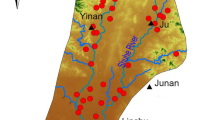Abstract
The empirical relationship between the mineralization of riverine waters and specific conductivity normalized to 15°C was obtained in testing Razdolnaya River water from March 2013 to April 2014. It was shown that the obtained equation made it possible to calculate the water mineralization to a satisfactory accuracy for rivers of calcium–carbonate type using data on the specific conductivity and temperature obtained with a hydrological probe. It was found that the anthropogenic impact of \({\text{NO}}_{3}^{-}\) and \({\text{NH}}_{4}^{ + }\) ions on the composition of riverine water caused no significant error when using the empirical relationship. The data of the experiments showed that the salinity measurements in estuarine waters by conductivity using the oceanographic logarithm could have resulted in great errors depending on mineralization of the riverine water. The algorithm was proposed for including corrections to obtain reliable salinity values in estuarine waters.



Similar content being viewed by others
REFERENCES
O. A. Alekin and L. V. Brazhnikova, Run-Off of Dissolved Substances from the Territory of USSR (Nauka, Moscow, 1964) [in Russian].
S. V. Bruevich and S. K. Demenchenok, Determination of Alkalinity in Small Volumes of Seawater by Direct Titration: Instructions for Chemical Studies of Seawater (Glavsevmorput’, Leningrad, 1944) [in Russian].
GOST (State Standard) 18164-72: Drinking Water, Method for Determination of Total Solids Content (Izd. Standartov, Moscow, 2003), pp. 348–350.
A. A. Zori, V. D. Korenev, and Yu. E. Markovskii, “Express test for determination of total mineralization of drinking water,” Nauk. Prats. Donetsk. Nats. Tekh. Univ., Ser.: Obchislyuv. Tekh. Avtom., No. 107, 135–142 (2006).
Methods of Hydrochemical Studies of General Biogenic Elements (VNIRO, Moscow, 1988) [in Russian].
G. Yu. Pavlova, P. Ya. Tishchenko, T. I. Volkova, A. Dickson, and K. Wallmann, “Intercalibration of Bruevich’s method to determine the total alkalinity in seawater,” Oceanology (Engl. Transl.) 48, 438–443 (2008).
R. A. Horne, Marine Chemistry. The Structure of Water and the Chemistry of the Hydrosphere (Wiley, New York, 1969; Mir, Moscow, 1972).
F. Culkin and N. D. Smith, “Determination of the concentration of potassium chloride solution having the same electrical conductivity, at 15°C and infinite frequency, as standard seawater of salinity 35.0000‰ (chlorinity 19.37394‰),” IEEE J. Ocean. Eng. 5 (1), 22–23 (1980).
Guide to Best Practices for Ocean CO 2 Measurements, PICES Special Publication 3, Ed. by A. G. Dickson, C. L. Sabine, and J. R. Christian (North Pacific Marine Science Organization, Sidney, BC, 2007).
N. P. Fofonoff and R. C. Millard Jr, Algorithms for Computation of Fundamental Properties of Seawater (UNESCO, Paris, 1983).
J. M. Gieskes, “The practical salinity scale 1978: a reply to comments by T. R. Parsons,” Limnol. Oceanogr. 27 (2), 387–389 (1982).
M. Le Menn and L. Pacaud, “Effect of sediment suspensions on seawater salinity assessments,” J. Water Res. Ocean Sci. 6 (2), 23–34 (2017).
E. L. Lewis, “The practical salinity scale 1978 and its antecedents,” IEEE J. Ocean. Eng. 5 (1), 3–8 (1980).
F. J. Millero, “The conductivity-density-chlorinity relationships for estuarine waters,” Limnol. Oceanogr. 26 (6), 1317–1321 (1984).
F. J. Millero, “Effect of changes in the composition of seawater on the density-salinity relationship,” Deep Sea Res., Part I 47, 1583–1590 (2000).
T. R. Parsons, “The new physical definition of salinity: biologists beware,” Limnol. Oceanogr. 27 (2), 384–385 (1982).
R. Pawlowicz, “Calculating the conductivity of natural waters,” Limnol. Oceanogr. Methods 6, 489–501 (2008).
A. Poisson, “Conductivity/salinity/temperature relationship of diluted and concentrated standard seawater,” IEEE J. Ocean. Eng. 5 (1), 41–50 (1980).
J. H. Sharp and C. H. Culberson, “The physical definition of salinity: a chemical evaluation,” Limnol. Oceanogr. 27 (2), 385–387 (1982).
T. M. Dauphinée, E. L. Lewis, J. Ancsin, M. J. Phillips, Culkin F., N. Smith, A. Poisson, A. L. Bradshaw, K. Schleicher, R. G. Perkin, and H. P. Klein, Background Papers and Supporting Data on the Practical Salinity Scale, 1978, UNESCO Technical Papers in Marine Science No. 37 (UNESCO, Paris, 1981).
W. S. Wooster, A. J. Lee, and G. Dietrich, “Redefinition of salinity 1966,” Limnol. Oceanogr. 14 (3), 437–438 (2003).
Funding
The study was performed under state task no. 0149-2019-0008 for the Institute of Oceanology, Russian Academy of Sciences, and supported partly by the Russian Foundation for Basic Research (project nos. 16-55-50 071 and 16-05-00166), as well as by the Far East Program (nos. 18-1-010 and 18-1-007).
Author information
Authors and Affiliations
Corresponding authors
Additional information
Translated by A. Rylova
Rights and permissions
About this article
Cite this article
Tishchenko, P.Y., Stunzhas, P.A., Pavlova, G.Y. et al. Algorithm for Calculating the Mineralization of Riverine Waters and Salinity of Estuarine Waters from Conductivity Data. Oceanology 59, 533–540 (2019). https://doi.org/10.1134/S0001437019040179
Received:
Revised:
Accepted:
Published:
Issue Date:
DOI: https://doi.org/10.1134/S0001437019040179




